UNS N08330 is an alloy that contains nickel, iron and chromium. It has several unique properties which make it a useful material for various industries. This blog post will provide an overview of Incoloy 330, including its composition, mechanical properties, physical properties, uses, corrosion resistance, heat resistance, heat treatment requirements, and machining and welding processes.
Incoloy 330 Composition
UNS N08330 is composed primarily of nickel (67%), iron (20%), chromium (14%), silicon (1%), and manganese (1%). It also contains small amounts of aluminium, cobalt, copper, molybdenum and titanium.
| Element | Content (%) |
|---|---|
| Iron, Fe | 43 |
| Nickel, Ni | 34-37 |
| Chromium, Cr | 17-20 |
| Manganese, Mn | ≤2 |
| Others | Remainder |
Incoloy 330 Mechanical Properties
Alloy 330 is a strong alloy with good ductility and impact strength, even at low temperatures. Its tensile strength ranges from 860 MPa to 1120 MPa depending on the size of the material being tested. The alloy also has an elongation percentage between 20% and 30%.
| Properties | Metric | Imperial |
|---|---|---|
| Tensile strength(annealed) | 600 MPa | 87 ksi |
| Yield strength(annealed) | 280 MPa | 40.6 ksi |
| Elongation at Break | 45% | 45% |
Incoloy 330 Physical Properties
Grade 330 has a density of 8.13 g/cm3, making it slightly heavier than other alloys such as stainless steel or aluminium. It also has a melting point range between 2100°F to 2350°F (1150°C to 1290°C). It can be easily machined due to its high ductility and can be formed into complex shapes with minimal effort.
| Properties | Metric | Imperial |
|---|---|---|
| Density | 8.08 gm/cm3 | 0.292 lb/in3 |
Incoloy 330 Equivalent
| UNS N08330 | SAE AMS 5592 | SAE AMS 5716 | SAE J405 | SAE J412 |
| ASTM B 511 | ASTM B 512 | ASTM B 535 | ASTM B536 | ASTM B546 |
| ASTM B710 | ASME SB-511 | ASME SB-536 | ASME SB-710 |
Incoloy 330 Uses
Incoloy alloy 330 is used in various applications across multiple industries, including aerospace engineering, automotive engineering, power generation equipment manufacturing, and medical device manufacturing. Due to its excellent corrosion resistance properties, it is also increasingly used in corrosive environments such as chemical processing plants or marine applications where it can withstand harsh conditions without degrading.
Corrosion Resistance
UNS N08330 is highly resistant to oxidizing and reducing acids, making it ideal for use in corrosive environments like seawater or wastewater treatment plants where other materials may not be suitable. Its excellent corrosion resistance comes from its high chromium content, which forms a protective layer on the surface when exposed to oxygen or water vapour, keeping the underlying metal safe from erosion or degradation due to contact with aggressive chemicals or saltwater exposure.
Heat Resistance
In addition to its corrosion resistance properties, Incoloy 330 is also known for its excellent heat resistance allowing it to work effectively in temperatures up to 2400°F (1300°C). This makes it a valuable material for applications such as furnace components or exhaust systems where high temperatures are common. Still, reliability must remain constant without compromising performance due to heat fatigue or oxidation damage.
Heat Treatment
To ensure optimal performance from an application made out of Incoloy 330 requires heat treating before use; this includes solution annealing at 2100°F – 2250°F followed by rapid cooling in the air, then tempering at 1300°F – 1400°F for one hour, followed by air cooling again; this ensures that any residual stresses created during forming are relieved while maintaining maximum strength characteristics in the finished part after machining operations have been completed.
Machining
Machining incoloy 330 requires more cutting speeds than regular stainless steel due to its higher hardness levels; however, coolants should always be used as they help reduce friction while machining and prevent overheating, which could lead to warping during fabrication processes if not properly managed.
Welding Process
Welding incoloy330 requires pre-heating before welding operations begin, usually around 1100-1200 degrees Fahrenheit; welders should also use special filler metals designed specifically for welding incoloys, such as AWS ERNiFeCr-2(AWS A5 .4 E Ni Fe Cr-2) as these provide better conductivity compared regular mild steel filler rods.
Conclusion
In conclusion,incoloy330 is an extremely versatile alloy that provides superior corrosion resistance and heat resistance capabilities and maintains good mechanical strength even when exposed to extreme temperature conditions. Its wide range of valuable applications makes it a popular choice across many industries where reliability is paramount under demanding conditions. For those looking to incorporate incolloys into their projects, it’s important to remember all necessary steps required to ensure optimal performance, such as proper heat treatment, coolant usage during machining operations &use of appropriate filler metals during the welding process before the final product is ready to use. By doing so, one can rest assured that they have done the best possible job ensuring their project’s success!

A passionate metal industry expert and blogger. With over 5 years of experience in the field, Palak brings a wealth of knowledge and insight to her writing. Whether discussing the latest trends in the metal industry or sharing tips, she is dedicated to helping others succeed in the metal industry.




